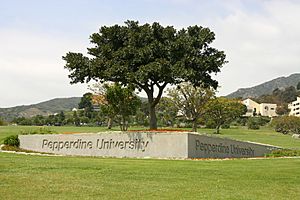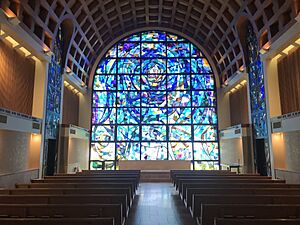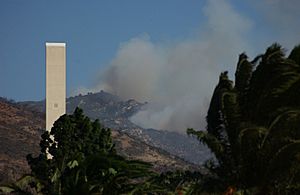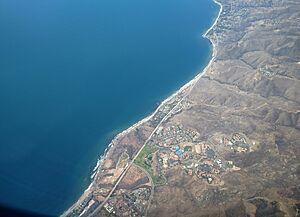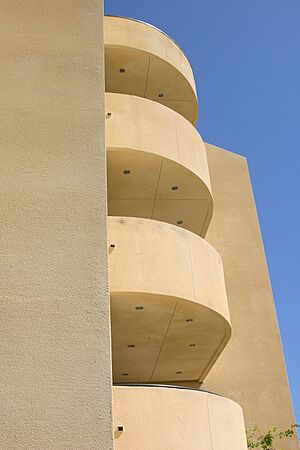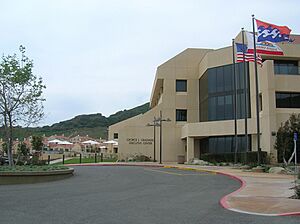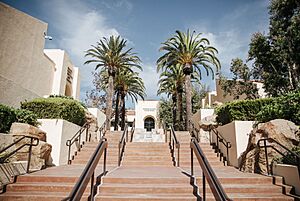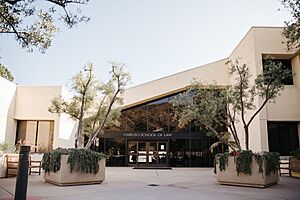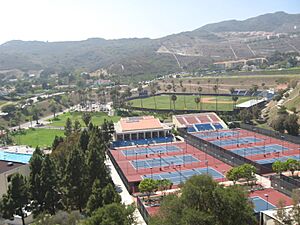Pepperdine University facts for kids
 |
|
|
Former names
|
George Pepperdine College (1937–1971) |
|---|---|
| Motto | Freely ye received, freely give |
| Type | Private research university |
| Established | 1937 |
|
Religious affiliation
|
Church of Christ |
| Endowment | $1.21 billion (2022) |
| President | Jim Gash |
|
Academic staff
|
421 full-time (2022), 561 part-time (2022) |
| Students | 10,030 (fall 2022) |
| Undergraduates | 3,662 (fall 2022) |
| Postgraduates | 6,368 (fall 2022) |
| Location |
,
,
United States
34°02′19.26″N 118°42′27.29″W / 34.0386833°N 118.7075806°W |
| Campus | Suburban 830 acres (340 ha) |
| Newspaper | Pepperdine Graphic |
| Colors | Blue and orange |
| Nickname | Waves |
|
Sporting affiliations
|
NCAA Division I – WCC |
| Mascot | Willie the Wave |
Pepperdine University is a private Christian university. It is connected with the Churches of Christ. Its main campus is in Los Angeles County, California, United States.
Pepperdine's main campus is huge, covering 830 acres (340 ha). It sits on a hill overlooking the Pacific Ocean and the Pacific Coast Highway near Malibu, California.
The university was started by a businessman named George Pepperdine in South Los Angeles in 1937. It later moved and grew to its Malibu location in 1972. Today, classes are taught at the main Malibu campus and at other campuses in the USA, Latin America, and Europe.
Pepperdine University has an undergraduate school called Seaver College. It also has four graduate schools: the Caruso School of Law, the Graziadio Business School, the Graduate School of Education and Psychology, and the School of Public Policy.
In 2025, Pepperdine University was recognized for its high level of research. This means the university does a lot of important research and has many research programs.
Contents
University History
How Pepperdine University Started
In February 1937, during a tough economic time called the Great Depression, George Pepperdine opened a college in Los Angeles. He wanted it to be a Christian college connected with the Churches of Christ.
George Pepperdine had become wealthy from his company, Western Auto Supply. He had two main goals for the college. First, he wanted to offer excellent academic training in many subjects. Second, he wanted to help students build a life like Christ, love the church, and care for others.
On September 21, 1937, the college welcomed 167 students. They came from 22 different states and two other countries. The new campus was built on 34 acres (14 ha) in South Los Angeles. By April 1938, the college was officially recognized as a good school. This was thanks to leaders like President Batsell Baxter and Dean Hugh M. Tiner.
The student newspaper, the Graphic, started publishing in October 1937. The college grew a lot in the years that followed. By 1948–1949, it had 1,839 students. The first graduate program, a master's degree in religion, began in 1944. The school's first international program, in Heidelberg, Germany, started in 1963.
Moving to Malibu
By 1957, when M. Norvel Young became president, the college faced challenges. The area around the original campus in South Los Angeles was changing. There were social tensions, and the cost of expanding the college there was very high.
President Young began looking for new places to expand the university. In 1966, a group looked at possible new locations. In 1968, a family who owned land near Malibu offered to donate 138 acres (56 ha) and sell more land. Even though building on the mountainside would be expensive, the school decided to move to Malibu because of its great location.
In March 1969, a difficult event happened when a teenager, Larry Kimmons, died after an argument with a campus security officer. This led to protests from Black students against the college's leaders. Some people believed the event was due to racism.
In December 1970, student protests became very serious, with some students even starting small fires in three buildings. Students later took over a building, leading to a tense situation with the police. This was resolved through talks with Vice President William S. Banowsky.
Construction in Malibu began on April 13, 1971. The new campus opened in September 1972. The famous architect William Pereira designed the campus and many of its buildings. The Malibu campus was built thanks to large gifts from Blanche Seaver. The undergraduate college was named Seaver College in her honor in 1975.
The university kept its original campus in South Los Angeles for a while. It built a new academic building there in 1970. However, most of the undergraduate programs moved to the new Malibu campus. In 1981, the original campus was sold to the Crenshaw Christian Center.
University Growth
| Presidents of Pepperdine | |
|---|---|
| President |
|
| Batsell Baxter |
|
| Hugh M. Tiner |
|
| M. Norvel Young |
|
| William S. Banowsky |
|
| Howard A. White |
|
| David Davenport |
|
| Andrew K. Benton |
|
| James A. Gash |
|
In 1969, Pepperdine bought a law school in Santa Ana, California. This became the School of Law and moved to the Malibu campus in 1978. What was once a business department became a graduate business school in 1968. In 1971, it was named the School of Business and Management. Also in 1971, the School of Education was created. It became the Graduate School of Education and Psychology in 1981. Because of all these new schools, the institution changed its name to Pepperdine University in 1971.
Pepperdine continued to grow. It added permanent international programs in London and Florence in 1984 and 1985. Later, programs were added in Buenos Aires, Lausanne, and Shanghai. The business school was renamed the Graziadio Business School. This was to honor a large gift from real estate developer George L. Graziadio Jr.. In 2019, the law school was renamed the Caruso School of Law after a big gift from alumnus Rick J. Caruso. The Malibu campus also expanded with the 50.4-acre (20.4 ha) Drescher Graduate Campus, finished in 2003.
Dealing with Brushfires
Pepperdine's Malibu Campus is sometimes threatened by brushfires. These fires happened in 1985, 1993, 1996, 2007, 2018, and 2024. The university gets ready for fires by clearing brush far away from buildings. It also has plans with the Los Angeles County Fire Department to keep everyone safe on campus during a fire.
Pepperdine University Campus

Malibu Campus Features
Pepperdine's Malibu campus is on 830 acres (340 ha) in the Santa Monica Mountains. It looks out over the Pacific Ocean and the Pacific Coast Highway. Many people think it's one of the most beautiful college campuses in the world. It has been called "a place that looks more like a beach resort than a private university." The campus offers amazing views of the Santa Monica Bay, Catalina Island, and the Palos Verdes Peninsula. Most buildings have a Mediterranean Revival Style. They have white walls, red tile roofs, and large windows. The first buildings were finished in 1973.
The most special part of the Malibu campus is the Phillips Theme Tower. It's a 125-foot tall tower with a cross built into it. The tower was designed in 1972 and finished in 1973. It was dedicated in 1974 to show Pepperdine's Christian mission. The cross has not been lit up since 1980 due to disagreements with local residents.
Alumni Park is at the lowest part of the Malibu campus, near the Pacific Coast Highway. It's a 30-acre area with lawns, paths, hills, and ponds. It's a beautiful spot overlooking the ocean. The park was dedicated in 1979. It is now used for graduation ceremonies and other big campus events. Overlooking Alumni Park is Stauffer Chapel. It has 3,000 square feet of beautiful stained-glass windows, made in 1973.
The main academic area for undergraduate students is on a hill above Alumni Park. It includes the Tyler Campus Center, Payson Library, and the Weisman Museum of Art. Student housing and sports facilities are to the northwest. The Caruso School of Law is on a hill above these areas.
The Drescher Graduate Campus is next to the central campus. It was finished in 2003. It is home to the School of Public Policy, the Villa Graziadio Executive Center, and programs for the Graziadio Business School and the Graduate School of Education and Psychology. It also has housing for students and teachers.
Other Campuses
The Graziadio Business School and the Graduate School of Education and Psychology have their main offices in West Los Angeles. These schools also offer programs at campuses in Malibu, Irvine, and Calabasas.
International Campuses
Pepperdine has permanent campuses in five other countries. These campuses offer semester-long and year-long programs for undergraduate students. The first international program opened in 1963 in Heidelberg. Programs then started in South Kensington, London in 1984, and in Florence in 1985. In 2023, the program in Lausanne moved to a new location in Switzerland.
Academics at Pepperdine
Seaver College: Undergraduate Studies
Seaver College is the undergraduate school at Pepperdine. It is named after Frank R. Seaver and his wife Blanche, who gave a lot of money to the Malibu campus. The college offers a wide range of subjects for students to study. All students must take a variety of general education courses. Many Seaver students also choose to study abroad at one of the university's international campuses in places like Buenos Aires, Florence, Heidelberg, Lausanne, and London.
Seaver College offers many different majors and minors. These are grouped into eight academic areas, including business, communication, fine arts, humanities, natural science, religion, and social science.
Besides bachelor's degrees, Seaver College also offers some graduate degrees. These include master's degrees in American studies and religion, and a master of fine arts in screen and television writing. Students can also get teaching credentials here.
Graziadio Business School
Pepperdine University's Graziadio Business School has about 2,000 students. It offers both full-time and part-time degree programs. The school started in 1969 and has had more than 47,000 graduates. In 2016, U.S. News & World Report ranked its online MBA program among the top 15 in the country.
Caruso School of Law
The Caruso School of Law is on the Malibu campus, next to Seaver College. It has about 500 students. The school is known for its Straus Institute of Dispute Resolution, which is highly ranked for helping people solve problems without going to court. The law school also offers programs where students can earn two degrees at once, like a law degree and a business degree. Students can also study at the university's campus in London.
In 2023, U.S. News & World Report ranked the law school 45th among law schools in the nation. It is also known for its entertainment law program.
Graduate School of Education and Psychology
The Graduate School of Education and Psychology (GSEP) offers master's and doctorate degrees. It has about 1,600 students. Its programs are recognized by the APA.
School of Public Policy
The School of Public Policy has about 70 graduate students. They study for a two-year master's degree in public policy (MPP).
Students can also combine this degree with others. For example, they can earn an MPP and a law degree, or an MPP and a business degree.
Student Life at Pepperdine
| Race and ethnicity | Total | ||
|---|---|---|---|
| White | 48% |
|
|
| Hispanic | 16% |
|
|
| Asian | 12% |
|
|
| Foreign national | 10% |
|
|
| Other | 8% |
|
|
| Black | 5% |
|
|
| Economic diversity | |||
| Low-income | 17% |
|
|
| Affluent | 83% |
|
|
In Fall 2023, Pepperdine had 9,545 students. This included 3,629 undergraduate students and 5,916 graduate students. In the 2017 school year, 91% of first-year students returned for their second year.
Fall freshman profile
| 2023 | 2022 | 2021 | 2020 | 2019 | 2018 | 2017 | |
|---|---|---|---|---|---|---|---|
| Applicants | 12,457 | 11,466 | 11,854 | 11,634 | 12,764 | 12,134 | 11,704 |
| Admits | 6,210 | 5,585 | 6,249 | 4,925 | 4,049 | 4,664 | 4,097 |
| % admitted | 49.9 | 48.7 | 52.7 | 42.3 | 31.7 | 35.0 | 39.8 |
| Enrolled | 732 | 942 | 1,024 | 733 | 726 | 803 | 862 |
| Average GPA | 3.65 | 3.75 | 3.74 | 3.69 | 3.67 | 3.66 | 3.64 |
| ACT range | 26–32 | 28–32 | 25–30 | 26–31 | 27–32 | 26–32 | 26–31 |
| SAT range | 1250–1440 | 1290–1460 | 1280–1430 | 1210–1390 | 1250–1430 | 1,700–2,020 | 1,670–2,020 |
How to Get In
For the undergraduate class of 2023, 13,721 students applied, and 4,241 were accepted (30%). Among the accepted students, their test scores and grades were very good. For example, their SAT scores were typically between 1,300 and 1,450.
U.S. News & World Report says that getting into Pepperdine is "more selective."
Support for Veterans
Pepperdine University helps military veterans pay for their education through the Yellow Ribbon Program. This program offers support for many veteran students. It also gives a lot of money towards each veteran's tuition. As of 2016, most Pepperdine students who are veterans were in this program, which helps them attend tuition-free.
University Rankings and Reputation
| USNWR National University | 76 |
|---|---|
| Washington Monthly National University | 197 |
| Forbes | 125 |
U.S. News & World Report ranked Pepperdine tied for the 55th best national university in 2022. It was also tied for 26th in undergraduate teaching and tied for 27th best college for veterans. Pepperdine was ranked number 1 in a 2015 report for having many undergraduate students study abroad. About 86.5 percent of all undergraduate students studied abroad in 2013–2014.
The law school was ranked 45th among law schools by U.S. News & World Report in 2023. It is known for its entertainment law and its dispute resolution program, which is ranked very high in the nation. In 2018, U.S. News & World Report ranked Pepperdine's business school 65th among business programs in the United States.
In 2019, Pepperdine received an "A" grade from the American Council of Trustees and Alumni. This grade is given to schools that require students to study at least six out of seven important subjects. Pepperdine was one of only 23 schools to get this top grade.
In 2025, Pepperdine University was recognized as a university with "High Research Activity." This means it does a lot of research and spends more than $5 million on research each year. It also awards many research doctorate degrees.
Pepperdine University Athletics
Pepperdine University competes in NCAA Division I sports. Most of its teams play in the West Coast Conference. However, the men's volleyball team plays in the Mountain Pacific Sports Federation. The men's water polo team plays in the Golden Coast Conference. Pepperdine's sports teams are called the Waves.
Pepperdine University often has one of the most successful sports programs for schools that don't have a football team. It has been ranked first three times and in the top three eight times in the last fifteen years. Pepperdine University has seventeen NCAA Division I sports teams. These include baseball, basketball, golf, tennis, volleyball, and water polo for men. For women, there are teams for basketball, golf, soccer, swimming, tennis, and volleyball. There are also other sports clubs like women's lacrosse and surfing.
Pepperdine athletes have won individual NCAA Division I titles:
- Robbie Weiss (1988 tennis – singles)
- Carlos Di Laura & Kelly Jones (1985 tennis – doubles)
- Jerome Jones & Kelly Jones (1984 tennis – doubles)
The water polo competitions for the 1984 Summer Olympics were held at the Raleigh Runnels Memorial Pool on campus.
Notable People from Pepperdine
More than 100,000 people who studied at Pepperdine University are living around the world. Famous alumni from Pepperdine University include scientists, musicians, business people, engineers, actors, and politicians. Many have achieved success both in the United States and internationally. The Pepperdine alumni network has more than 30 groups on four continents.
Pepperdine University Demographics
|
Pepperdine University CDP
|
|
|---|---|
| Country | United States |
| State | California |
| County | Los Angeles |
| Area | |
| • Total | 0.538 sq mi (1.39 km2) |
| • Land | 0.538 sq mi (1.39 km2) |
| • Water | 0 sq mi (0 km2) |
| Elevation | 482 ft (147 m) |
| Population
(2020)
|
|
| • Total | 2,747 |
| • Density | 5,106/sq mi (1,971.4/km2) |
| Time zone | UTC−8 (Pacific) |
| • Summer (DST) | UTC−7 (PDT) |
| GNIS feature ID | 2805260 |
The United States Census Bureau has named the Pepperdine University campus as its own special area for counting people. In the 2020 Census, it had a population of 2,747 people.
The campus is located within the Santa Monica-Malibu Unified School District.
| Historical population | |||
|---|---|---|---|
| Census | Pop. | %± | |
| 2020 | 2,747 | — | |
| U.S. Decennial Census 2020 |
|||
2020 Census Information
| Race / Ethnicity (NH = Non-Hispanic) | Pop 2020 | % 2020 |
|---|---|---|
| White alone (NH) | 1,626 | 59.19% |
| Black or African American alone (NH) | 223 | 8.12% |
| Native American or Alaska Native alone (NH) | 70 | 2.55% |
| Asian alone (NH) | 660 | 24.03% |
| Native Hawaiian or Pacific Islander alone (NH) | 6 | 0.22% |
| Other Race alone (NH) | 0 | 0.00% |
| Mixed race or Multiracial (NH) | 26 | 0.95% |
| Hispanic or Latino (any race) | 136 | 4.95% |
| Total | 2,747 | 100.00% |
See also
 In Spanish: Universidad Pepperdine para niños
In Spanish: Universidad Pepperdine para niños
- List of universities and colleges affiliated with the Churches of Christ


